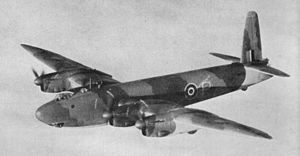Vickers Windsor
| Windsor | |
|---|---|
 |
|
| Role | Heavy bomber |
| Manufacturer | Vickers-Armstrongs (Aircraft) Ltd. |
| First flight | 23 October 1943 |
| Status | Prototype |
| Primary user | Royal Air Force |
| Produced | 1943-1944 |
| Number built | 3 |
The Vickers Windsor was a Second World War British four-engine heavy bomber, designed by Barnes Wallis and Rex Pierson at the Vickers-Armstrongs factory at Brooklands.
As a possible replacement for the pre-war Vickers Wellington medium bomber, Vickers had proposed a series of designs. The first, to meet the same specification as the Bristol Buckingham and Air Ministry Specification B.11/41, was for a high speed twin-engined medium bomber, with remote controlled turrets in engine nacelles and guns in the nose. This was considered to be neither fast enough to be a fast bomber nor well armed enough to be a normal medium bomber. A four-engined development of the same design was also drawn up. The official position was that the Wellington was becoming obsolete but as the Vickers factories were set up only for geodesic construction any design would need to be based on that method. Vickers were working on a Wellington with a pressurised cabin for high altitude work and the Ministry was interested in a pressurized version of Warwick; this was supported by Lord Beaverbrook. The proposed design changed the twin-engined Warwick wing for an elliptical wing with four Merlin engines. The aircraft was expected to manage 43,000 ft (13,000 m) having delivered 8,000 lb (3,600 kg) of bombs. The contract for two prototypes of the Warwick was covered by Specification B.5/41 and development and construction work proceeded until September 1942. In mid-1942, the Wellington replacement and B.5/41 were merged as a result of a new specification - B.3/42 - for a Lancaster replacement but without high altitude performance. Vickers could take the work already done along and fit the four-engine wing to a new design of fuselage and a contract was raised for what would become the Windsor. The wings of the first prototypes were built to the earlier specification and so had lower weight limits imposed.
...
Wikipedia
